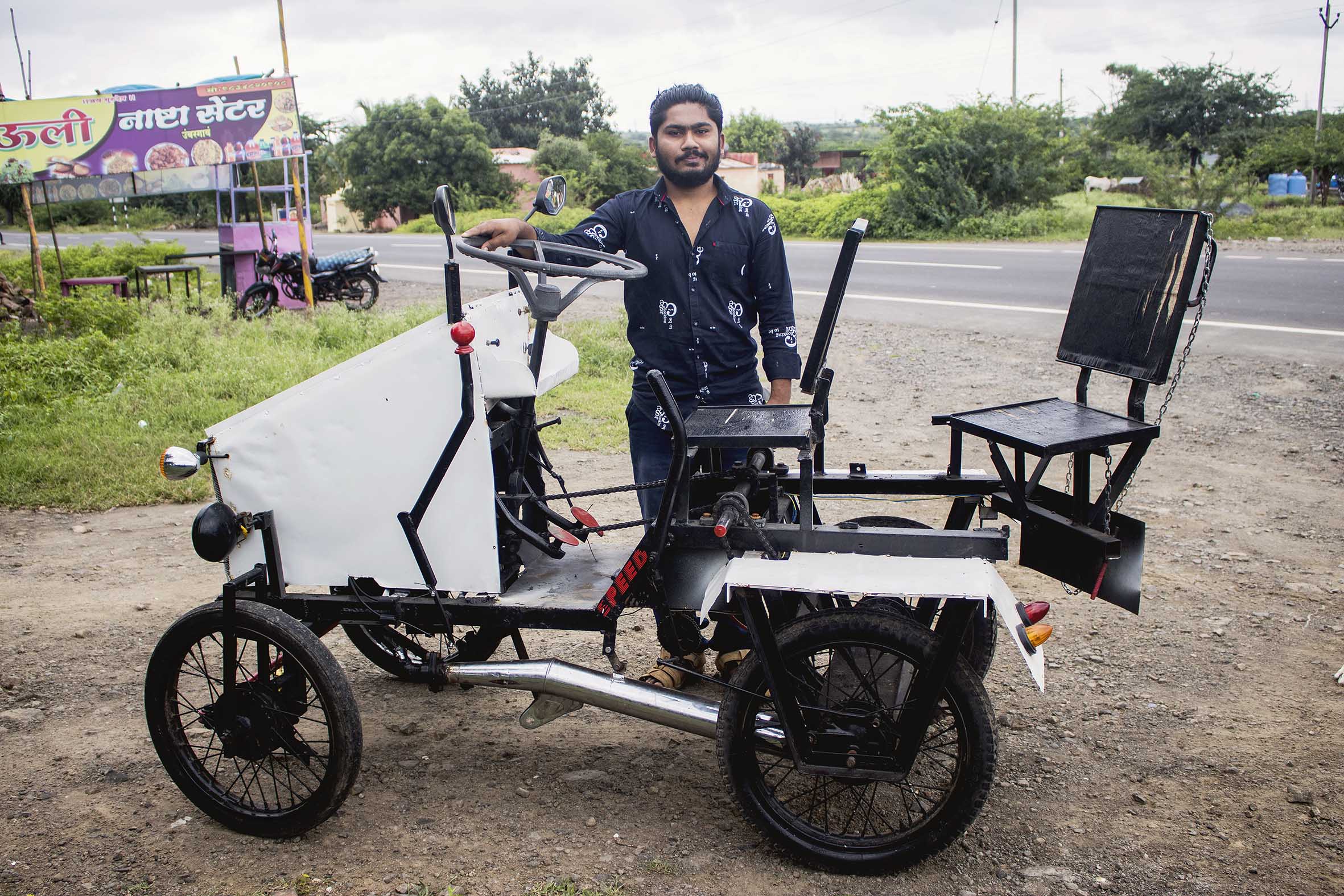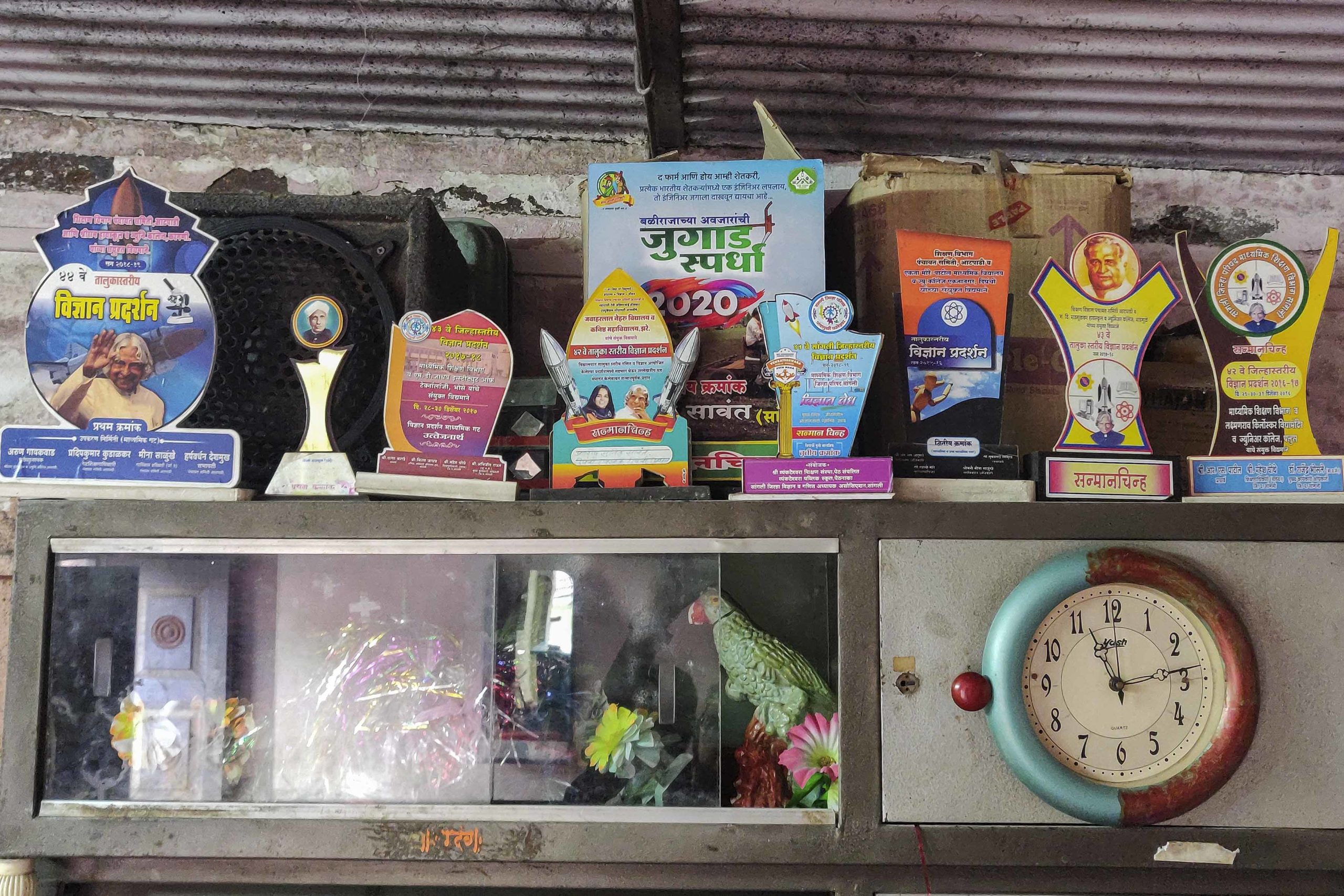The inventor changing the lives of Indian farmers
A young Indian’s innovative tools, ingeniously made from recycled and scrap materials, ease workers’ tasks, saving them time, money and energy.
Author:
11 October 2021

When Sumati Sawant, 40, got a bumper 5 000kg peanut harvest, she cheered with joy. Hers is a drought-prone region and harvest yields often disappoint. “How are we going to peel so [many peanuts]?” she even wondered.
Her youngest son, Ashish Sawant, 21, began working on a solution.
Sawant spent a day drawing a design. Next, he picked up pieces of scrap metal, welded them together according to his design and began experimenting. In less than a week, what used to be scrap turned into a workable solution – a peanut peeler.

“It requires no battery,” he says proudly. “You just have to put the [peanuts] in it and move the shaft around the edges of the semi-circular design.” The pressure peels off the husk, and the separated peanuts fall through. “If you can bring down 30 minutes of hard manual labour to two minutes, isn’t it good enough?” he asks.
New options for farmers’ struggles
This invention not only solved his mother’s problem but also helped several hundred farmers from different Indian states. Sawant now gets requests to make this machine from farmers living in the states of Chhattisgarh, Rajasthan, Madhya Pradesh and Gujarat – all of which are many kilometres from his remote village.
A manual peanut peeler costs at least 15 000 Indian rupees (R3 000) on the market. Sawant made it for less than R290. “The majority of the farmers across the world can’t afford costly machines. It’s time to start thinking about building low-cost solutions,” he says.
Sawant says every process in farming can be revolutionised and made simpler using science and technology. He has built more than 30 machines and tools, 15 of which cater to farming. Every innovation of his stems from a problem. A resident of Umbargaon village in Maharashtra State, he completed an Industrial Training Institute course in welding. The school is in Atpadi, a town 16km from his village. Sawant, who rejected two corporate job offers in the middle of the Covid-19 pandemic, says: “I want to make a career in innovation and solve people’s problems using scrap and science.”

He comes from a background in farming and, together with his father and two uncles, owns 10 acres of land. “I farm as I get time from these innovations. However, since this is a drought-prone region, we barely get any good produce.” Reducing the cost of farming makes a huge difference in these circumstances.
Talking about why he remains interested in farming, he says: “There are several people in rural areas who practise farming. Not many people want to understand the problems of farmers and innovate for us.”
One of the many problems facing farmers in India and across the world is venomous snakes. According to the World Health Organization, snakes kill between 81 000 and 138 000 people every year worldwide. The majority of the victims are farmers or agricultural workers. In the past 20 years, India has lost 1.2 million people to snakebites. The country reports more than half of global snakebite deaths. Many survivors are left with disabling conditions.
Sawant found out that it takes six months to learn to rescue snakes. He then began thinking of a tool that could save both the snake and the farmer. He designed a metallic clamp connected to a 1.5m-long iron rod, and attached a brake on one end. The brake’s movement controls the clamp. “The moment you press the brake, the clamp opens, and one can easily rescue the snake without getting hurt. All you need is courage,” he says. “A few rescuers tried this innovation, saying it works perfectly.” The invention has brought down snakebite cases in Umbargaon.
Low-cost innovations
According to the Landesa Rural Development Institute, more than 400 million women are involved in farm work around the world. In sub-Saharan Africa, women undertake 60% to 80% of the farm labour. In India, 85% of rural women are involved in farming. These women have to depend on poorly designed tools for their work. Sometimes, they have no tools at all and have to make do with their hands. Sawant hopes to change this.
Sowing and other farming activities involve a lot of bending and squatting. This affects the backs of older farmers especially. In response to this problem, Sawant made a manual seed-drill machine that stands just under a metre high. “You just need to put the seeds in the hole and push the device ahead,” says Sawant, who has been using it for two years. This helps both in tilling the soil and planting equidistant seeds. Once Sawant creates these devices, he asks farmers to test them, making relevant changes as they are suggested.
Weeding is another laborious task. “Even this work involves bending,” he says. So Sawant designed a simple bicycle-like structure with a single tyre. It costs R290. “You just need to drag this over the weeds, and the metallic frame helps uproot the weeds,” he explains.
Farmers, especially those without electricity, also often have to fetch water from wells. By studying traditional hand-pump designs, Sawant made a 6m-long portable version using PVC piping.
As a welder and innovator, Sawant often requires different machines for his work. “A spot-welding machine costs at least 30 000 Indian rupees [R5 800] … which is unaffordable.” So, he made a slightly smaller one for less than R2 300. It does the same job. He also made a bench drilling machine and a bench grinder.
Sawant likes to experiment with new ideas. “There are selfie sticks in the market, but I was curious to know how a selfie would look like from [5m].” He then brought together a Bluetooth shutter button, trash PVC pipe, a mobile stand and a PVC connector, and made a long selfie stick. “I am working on improving this design, but this is a good replacement for costlier wide-angle lenses. You can even use it to take drone-like shots,” he says, laughing.
The inventor has also made tongs for lifting bricks. “Lifting bricks a thousand times a day is quite hectic.” There are brick tongs that ease the process but are expensive. Sawant designed tongs that cost R100. Something similar goes for more than R500 on the market. “It can lift from two to 10 bricks in one round,” he says.
Nothing out of bounds
“People got to know more of my innovations after a local media channel, Vajradhari News, broadcast the story of my vehicle,” says Sawant.
During the early days of the Covid-19 lockdown, Sawant stumbled upon his father’s discarded two-wheeler. “We wouldn’t have fetched a good price anyway, so I removed its engine and began designing my own two-seater car,” he says. Soon, he began making the wired connections. “At first, it was difficult, but I started studying more about automobiles.” He did not do this by watching YouTube videos. Instead, he began observing the vehicles in his village, often opening their bonnets. When in doubt, he dials his college professors. “That’s the last resort. I keep experimenting, and it has always worked.”
“Assembling the car’s steering [wheel] was challenging but, after several trials, I was successful,” he says. He named his vehicle A004 and uses it for his everyday commute and farm work. “It has three gears, and everything else is just like the cars you see in the market.”
The car is partly solar and partly petrol operated, but he’s now working on converting it to 100% solar power. So far, the car’s headlights, brake lights, music system, indicators and hooter work on solar power. Sawant spent R7 770 making the entire vehicle. A similar one would cost at least R97 000 on the market. “This vehicle has a good mileage of 40km per litre of fuel, while similar ones in the market have half the mileage.”

Sawant, whose philosophy is to keep his inventions low-cost while simplifying the process, began creating things in grade 9 when he made a sprinkler from trash. It caught his science teacher’s attention. After that, he competed in several science competitions at local, district and state level – ultimately winning more than 10 prizes.
“We support him wholeheartedly and encourage him to do more,” says his mother. “During my time, I couldn’t study beyond grade 10, but I want my children to study whatever interests them.” His father, Sunil, 50, works as a farmer and collects milk from nearby villages, delivering it to cooperatives.
Sawant is not done inventing. He is now working towards building a two-seater helicopter. “I am not sure if it will work, but what’s the harm in trying?” He has procured scrap and other raw materials for this project. As he gets back to his welding table, he says, “Welding, in simple language, means joining metals. I want to weld everyday problems with their simple solutions.” Meanwhile, he gets a call from a distant farmer: another problem, likely another innovation.




